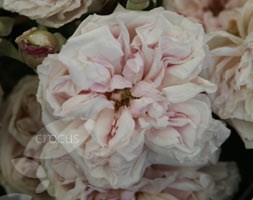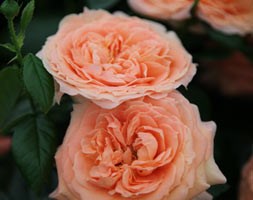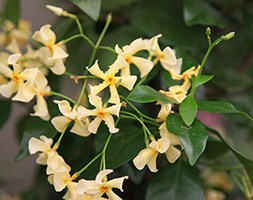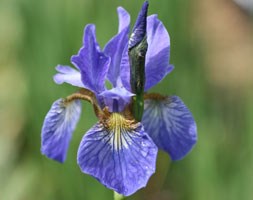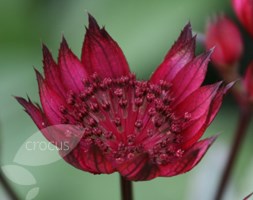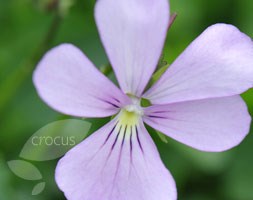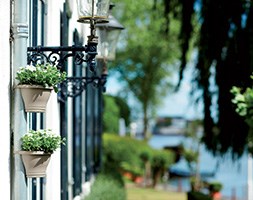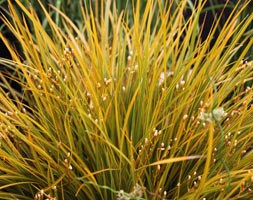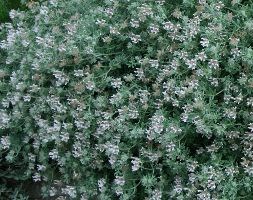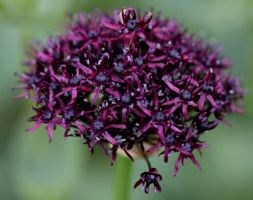New products at Crocus
by Sarah - July 12th, 2013.Filed under: Crocus, New Products.
Crocus has these new items today
Rosa ‘Souvenir de la Malmaison’ (rose (shrub)) £19.99
Position: full sun Soil: fertile, humus-rich, moist, well-drained soil Rate of growth: fast-growing Flowering period: June to September Flower colour: Orange Other features: excellent cut-flowers Hardiness: fully hardy Huge quartered flowers of blush white starts to flower late but then continues w ith reliability. The scent is splendid All our roses are grown in an open field and then dug up when the weather conditions are right in October or November. Some suppliers send out their roses as ‘bare root’ plants (ie without pots or compost), but we pot ours up as it helps to keep the roots hydrated and in good condition. As they are dormant throughout the winter, they will not produce any new roots until spring, so don’t be surprised if the compost falls away from the roots when you take them out of their pots. The roses can be kept in their pots throughout the winter provided they are kept well fed and watered, however ideally they should planted out as soon as possible. They will already have been cut back so no further pruning will be required, apart from snipping off any tips that have died back. Routine pruning can begin in late winter the year after planting. Garden care: If planting in winter, choose a frost-free spell when the soil is not frozen. Roses are quite deep-rooted plants so dig a deep hole roughly twice as wide as the plants roots and mix in a generous amount of composted organic matter. A top-dressing of a general purpose fertiliser can be worked into the surrounding soil and we also recommend using Rose Rootgrow at this stage to encourage better root development. This is particularly important when planting into a bed where roses have previously been grown as Rose Rootgrow is said to combat rose sickness (aka. replant disease). Remove the plants from their pots and gently spread out the roots before placing them in the centre of the hole. Try to ensure that the ‘bud union’ (the point where the cultivated rose has been grafted onto the rootstock, and from where the shoots emerge) is at soil level. You can judge this quite easily by laying something flat, like a spade handle or bamboo cane, across the top of the hole. When they are at the right height, back-fill the hole, firming the soil down gently before watering the plant well. Water generously until well established, and apply a specialist rose fertiliser (following the manufacturers instructions) each
Rosa Lady Marmalade (‘Hartiger’) (Rose of the year 2014) £17.99
Position: full sun Soil: fertile, humus-rich, moist, well-drained soil Rate of growth: fast-growing Flowering period: June to September Flower colour: Orange Other features: excellent cut-flowers Hardiness: fully hardy All our roses are grown in an open field and then dug up when the weather conditions are right in October or November. Some suppliers send out their roses as ‘bare root’ plants (ie without pots or compost), but we pot ours up as it helps to keep the roots hydrated and in good condition. As they are dormant throughout the winter, they will not produce any new roots until spring, so don’t be surprised if the compost falls away from the roots when you take them out of their pots. The roses can be kept in their pots throughout the winter provided they are kept well fed and watered, however ideally they should planted out as soon as possible. They will already have been cut back so no further pruning will be required, apart from snipping off any tips that have died back. Routine pruning can begin in late winter the year after planting. Garden care: If planting in winter, choose a frost-free spell when the soil is not frozen. Roses are quite deep-rooted plants so dig a deep hole roughly twice as wide as the plants roots and mix in a generous amount of composted organic matter. A top-dressing of a general purpose fertiliser can be worked into the surrounding soil and we also recommend using Rose Rootgrow at this stage to encourage better root development. This is particularly important when planting into a bed where roses have previously been grown as Rose Rootgrow is said to combat rose sickness (aka. replant disease). Remove the plants from their pots and gently spread out the roots before placing them in the centre of the hole. Try to ensure that the ‘bud union’ (the point where the cultivated rose has been grafted onto the rootstock, and from where the shoots emerge) is at soil level. You can judge this quite easily by laying something flat, like a spade handle or bamboo cane, across the top of the hole. When they are at the right height, back-fill the hole, firming the soil down gently before watering the plant well. Water generously until well established, and apply a specialist rose fertiliser (following the manufacturers instructions) each spring. They will also benefit from a generous mulch of composted farmyard manure in spring, but make sure this is k
Trachelospermum asiaticum (Chinesse jasmine) £17.99
Position: full sun or partial shade Soil: fertile, well-drained soil (or loam-based potting compost such as John Innes no. 3 for container-grown specimens) Rate of growth: initially slow-growing Flowering period: July and August Flower colour: creamy-white aging to yellow Hardiness: frost hardy (needs winter protection) Clusters of jasmine-scented, creamy-white, tubular flowers in mid- and late-summer and lustrous, dark green leaves. This versatile, evergreen climber is perfect for covering a sheltered, sunny house wall or training through a robust tree. In areas where winter temperatures fall below -10 degrees centigrade it’s best grown under glass in a large, cool greenhouse or conservatory. Garden care: In February or March trim to keep within bounds.
Iris sibirica ‘Blue King’ (Siberian iris) £14.99
Position: full sun or partial shade Soil: well-drained, moderately fertile soil Rate of growth: average Flowering period: May and June Flower colour: pale lavender and white Other features: all parts of the plant may cause severe discomfort if ingested; contact with the sap may cause skin irritation Hardiness: fully hardy Ravishing, rich purple-blue, ruffled flowers with yellow markings appear in May and June above the slender, strap-shaped leaves. This stately Siberian iris is perfect for providing vertical interest in a sunny border with well- drained, fertile soil. A relatively tall variety it’s important to stake the branched stems with bamboo canes in early spring well before the flowers appear. Garden care: Plant shallowly with the upper part of the rhizome sitting on the surface of the soil, incorporating a low-nitrogen fertiliser in the planting hole. After planting remove the upper-most third of the leaves to minimise the incidence of wind rock. In exposed areas stake with bamboo canes in early spring. White tinted lavender standards white with violet flecked style arms, light violet with white signals, veined falls.
Astrantia major ‘Claret’ (masterwort) £9.99
Position: full sun or partial shade Soil: fertile, moist, preferably humus-rich soil Rate of Growth: average to fast Flowering period:June to August Hardiness: fully hardy This is one of the darkest-flowered astrantias, with deep, ruby red pincushion-like flowers with a ruff of longer bracts than many other varieties. The leaves are pretty, too; deeply lobed and dark green. Although it is an old cottage-garden favourite, this astrantia works equally well in contemporary-style plantings. Use towards the front of a sunny, yet moist border, where the flower colour can be fully appreciated. Astrantias have been cultivated in Britain since the 16th century and have numerous common names, such as melancholy gentleman, Hattie’s pincushion and the more well-known masterwort. Garden care: Astrantias do not like to dry out. Incorporate plenty of organic matter when planting and water well in dry weather especially newly established plants. Lift and divide large clumps in early spring and apply a generous 5-7cm mulch of well-rotted manure or garden compost around the plant. Divided specimens may take some time to establish since they don’t like having their roots disturbed.
Viola cornuta ‘Victoria’s Blush’ (horned violet) £7.99
Position: full sun or partial shade Soil: fertile, humus-rich, moist, well-drained soil Rate of growth: average to fast-growing Flowering period: May to August Flower colour: pure white Hardiness: fully hardy Throughout the summer, delicately scented pale pink flowers appear, each flushed a slightly deeper pink at the outer edges of their petals and streaked with bright magenta near their eye. Gently spreading in habit, the mainly evergreen foliage will form soft drifts, filling gaps at the front of the border, or tumbling over the edge of a pot. Garden care: To minimise the risk of fungal diseases always use new, sterilised compost for container plants. Deadhead regularly to prolong flowering. Cut back after flowering to maintain a neat, compact shape.
Drain pipe flower pot £6.99
Our new funky drain pipe pot is made out of 100% weatherproof resin and comes in 4 funky colurs. The strap at the back tightens around your downpipe so it holds tightly on to the down pipe without any worry of it falling once it is planted. This is a great addition to your balcony which can be filled with some beautiful plants to hide those ugly down pipes! Size – 24cm (round at the top) Available in more than one colour. All colours sold separately.
Libertia ixioides ‘Goldfinger’ (Libertia) £6.99
Position: full sun Soil: fertile, moist but well-drained soil Rate of growth: average Flowering period: May to June Flower colour: white Hardiness: fully hardy Fantastic golden, evergreen grass-like foliage with bright central yellow stripe. Pure white starry flowers in late spring, followed by yellow berries in autumn. Its compact and neat habit makes this a bright feature in pots or in the front of the border. Grow hungry for best colour (40cm x 40cm) . Garden care: Selectively cut out old foliage to reveal attractive new growth. Dislikes being too wet in winter, and will benefit from a dry mulch in autumn. Divide congested plants in spring or autumn. Leave the spent flower spikes to mature and form attractive seed heads.
Lotus hirsutus (trefoil) £6.99
Position: full sun Soil: fertile, well-drained soil Rate of growth: average Hardiness: fully hardy (borderline) A small shrubby-perennial with erect stems and pretty, yellow, pea-like flowers flushed with orange. The flowers appear from late summer to early autumn and are followed by reddish-brown seed pods. As the name suggests, the leaves are covered with tiny hairs that give a silvery effect. Originally from the Mediterranean and Portugal, this evergreen plant can cope with drought once established and associates well with other silver-leaved plants. However, as it comes from much drier countries, it doesn’t like being wet in winter. Garden care: Protect plants in winter from excessive wet and if you live in a colder part of the country, the protect from hard frosts.
Allium atropurpureum (ornamental onion bulbs) £4.99
Position: full sun Soil: fertile, well-drained soil Rate of growth: average to fast Flowering period: May to June Hardiness: fully hardy Bulb size: 7/8 A new addition to our range of Alliums, that immediately shot to the top of our wish-lists. In early to mid summer, each upright stem is crowned with a rounded cluster of small flowers, which seem to hover like large, brilliantly coloured jewels above the foliage. Each flower is made up of deep pink to purple petals surrounding a blueberry-purple centre, which creates a vibrant and exciting contrast of colours. Their drumstick shape is great for adding diversity to the border, while their sturdy stems makes them ideal for cutting. If left in the border after the flowers have faded though, the subsequent seed heads will add months of structural interest. Garden care: Plant bulbs 15cm deep and 15cm apart to enjoy the full effect of the flowers. Avoid excessive moisture from late summer when they become dormant. Over-large clumps can be lifted and divided in autumn or spring.







